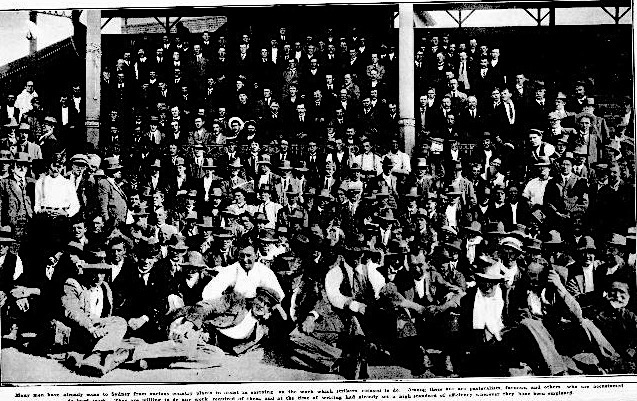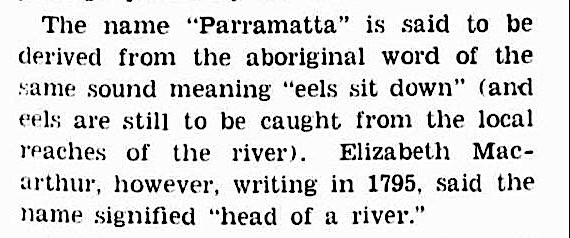 |
| Macquarie St Gatehouse, built in 1887, Corner of Pitt & Macquarie St Parramatta Park Parramatta NSW |
Parramatta is Australia's second oldest city.
Parrramatta Park is a park and historic site in Western Sydney, NSW.
Located on the edge of Parramatta CBD, Parramatta Park has 85 hectares of lawns and is about 27 km from Sydney CBD.
The Darug people who have
lived in the area for thousands of years, called the territory Burramatta.
More info. |
| A native camp near Cockle Bay, New South Wales with a view of Parramatta River, taken from Dawes's Point / drawn by J. Eyre; engraved by P. Slaeger [sic]. Published 1812 |
The Darug people lived in family groups of five to 60 people and each group had its own territory and
traditional rights and responsibilities.
In April 1788, Governor Arthur Phillip of the First Fleet explored the Parramatta River and established a fortified camp on a hill overlooking Parramatta Park.
Parramatta Park was where the first successful farms grew sufficient food to feed the colony.
Governor Phillip named a
natural landform feature, The Crescent, and in November 1788, Phillip sent convicts to establish agriculture here. You can visit The Crescent today.
Government House at Parramatta was completed by Governor Hunter in 1799 and ten governors of New South Wales from 1788 to 1857 occupied the building. Today, it is Australia's oldest public building and is opened to the
public.
 |
| OLD GEORGE-STREET, Parramatta, NSW, in 1791. |
Dairy Cottage, at Parramatta Park, was built between 1798 and 1821, in part by ex-convict George Salter. Later, the building was converted to a dairy by Governor Macquarie.
On 28 December 1814, Governor Macquarie had his first meeting with Aboriginal peoples of the Cumberland Plain at Parramatta. Maria, the daughter of Yarramundi "Chief of the Richmond Tribes" became the first student of the Native Institution, voluntarily admitted by her father.
Maria was a successful student of the Native Institution and won a prize in an examination. Read
more  |
| Sydney Gazette and New South Wales Advertiser (NSW : 1803 - 1842), Sunday 23 December 1804 |
The Parramatta Observatory was established by Governor Brisbane, who was educated in astronomy and mathematics at the University of Edinburgh, in March 1822, on the grounds of Government House. The observatory's major contribution was Rümker's rediscovery of Encke's comet in 1822.
The Bath House at Parramatta Park was constructed in 1823 for Governor Brisbane, whereby water was pumped through lead pipes from the nearby river. It was later converted into a pavilion.
The original Macquarie Street Gatehouse building was constructed in 1848, The present house built in 1887, was built around this
original dwelling.
Parramatta Park is one of the earliest gazetted public parks in Australia, dedicated as a park in 1857.
Between 1859 and 1889,
large parts of the Government Domain of Parramatta Park were subdivided into the suburbs of Westmead and Northmead.
 |
| Church St, Parramatta, NSW, in 1861, Sydney Mail (NSW : 1912 - 1938), Wednesday 26 October 1938, |
The George Street Gatehouse was built on the site of Governor Macquarie's small stone lodge in 1885.
 |
| Sydney's Hunt Club at Parramatta Park, NSW, 1906 |
 |
| The Soldiers' Memorial, Parramatta Park, NSW, Australian Town and Country Journal (Sydney, NSW : 1870 - 1919), Wednesday 22 November 1911 |
 |
| "Entrance to Parramatta Park," by John Henry Harvey (ca. 1880–ca. 1934), featuring the George Street 'Tudor' Gatehouse. The horse and cart stand in front of a building on the corner of George and O'Connell Streets, a location which is thought to have been the site of the first public brewery in Australia (established 1803).SLVIC |
Strangely, in the 1930s, a Zoological Garden
existed at Parramatta Park. Read
more |
| Parramatta Gatehouse, NSW, 1935, (There are six gatehouses in Parramatta Park located at the entrances on George Street (the Tudor Gatehouse), Ross Street, Park Road, Macquarie Street, Great Western Highway at Mays Hill and Queens Road) |
 |
| AT THE PARRAMATTA (N.S.W.) 150th ANNIVERSARY (Government House) Australasian (Melbourne, Vic. : 1864 - 1946), Saturday 12 November 1938, |
 |
| The atmosphere of an early-colonial vice-regal reception and garden party was recaptured during the150th birthday celebrations at Parramatta, NSW, Sydney Mail (NSW : 1912 - 1938), Wednesday 9 November 1938 |
In the early 1950s, motor races went through the park.
 |
| Car race at Parramatta Park, NSW, Sunday Herald (Sydney, NSW : 1949 - 1953), Sunday 7 September 1952 |
 |
GHOST of Lady Mary Fitzroy, killed nearby in 1847, is still said to appear on the columned
porch of Old Government House, Parramatta. Once the seat of colony's early Governors, the building is now The King's School Junior House. Sun (Sydney, NSW : 1910 - 1954), Friday 19 March 1954 |
In 2010, Parramatta Park with Old Government House was one of the 11 Australian Convict Sites listed on the UNESCO World Heritage Register.
There are two children's playgrounds and a sealed off-road area to ride bikes at Parramatta Park.
Around Parramatta Park |
| The Bath House at Parramatta Park, NSW, was constructed in 1823 for Governor Brisbane. Now a pavillion |
 |
| The observatory at Parramatta Park, NSW, was built by Governor Brisbane in 1822 and was used to make some of the most important early astronomical observations in the southern hemisphere (The observatory’s transit stones – which originally supported a transit telescope) |
 |
| The Soldiers' Memorial. Canons from the 1850s defense of the Port Jackson, now at Parramatta Park, NSW |
 |
| There are six gatehouses in Parramatta Park, NSW, located at the entrances on George Street (the Tudor Gatehouse), Ross Street, Park Road, Macquarie Street, Great Western Highway at Mays Hill and Queens Road. |
 |
| There are six gatehouses in Parramatta Park, NSW, located at the entrances on George Street (the Tudor Gatehouse), Ross Street, Park Road, Macquarie Street, Great Western Highway at Mays Hill and Queens Road. (Mays Hill Gatehouse, built 1869 at the Southern entrance to Parramatta Park) |
 |
| The oldest surviving public building in Australia, Old Government House is a heritage-listed former "country" residence used by ten early governors of New South Wales between 1800 and 1847, located in Parramatta Park, NSW |
Places To GoVirtual Tour of Parramatta Park
Parramatta Park -Macquarie St, Parramatta, AU 2150The Lancer Barracks is made up of several historic buildings built in c1820, including the Georgian building of Linden House – home to the Lancer Museum.
View archaeological remains from the early settlement of Parramatta at Philip Ruddock Heritage Centre.
Harris Park Heritage Area encompasses important historic landmarks such as Experiment Farm Cottage, Elizabeth Farm Cottage and Hambledon Cottage.
Female Orphan School was commissioned in 1813 by Governor Macquarie to provide a place to train orphaned, convict and Aboriginal females as domestic servants.
Parramatta Female Factory
Newington Armory was used as an explosives store during WWII.
Parramatta Town Hall - the foundations were laid in 1792.
Lennox Bridge was completed in 1839, designed by David Lennox.


































































